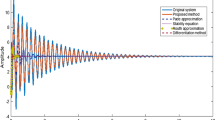Abstract
The chapter presents a method of reducing the time spent on the experimental study of the frequency properties of a plant with an unknown mathematical model, based on the application of a cyber-physical approach to experiment automation. The processing of experimental data on the response of plant output to an input signal formed as the mixture of harmonic components with different frequencies provides the nonparametric estimation of unknown plant’s frequency characteristics. To divide the output signal into components corresponding to each frequency, computer technology is used, which implements an optimization procedure for finding the values of both the real and imaginary frequency characteristics corresponding to the frequencies represented in the harmonic input signal. The method is also suitable for quick estimation of the frequency characteristics of a plant with an unknown time delay. The chapter considers the application of the frequency properties estimation in the problem of stability analysis of closed-loop systems destined for the plant with incomplete information about its model using a serial connected proportion-integral controller. The results of quick frequency characteristics estimation were applied to transfer function parameters identification. To solve the parameterization problem, the facilities of open source software for numerical computation Scilab were applied for the automatic converting the point-wise frequency characteristics to the corresponding transfer function. The example illustrating the design possibilities of the control system with the plant’s reduced model shows one of the possible applications of the transfer function’s parametric identification results.
Access this chapter
Tax calculation will be finalised at checkout
Purchases are for personal use only
Similar content being viewed by others
References
Fomin, O., Akimova, A., Akimova, J., Mastepan, A.: The criteria choice of evaluating the effectiveness of the process and automatic control systems. Procedia Comput. Sci. 149, 246–251 (2019). https://doi.org/10.1016/j.procs.2019.01.130
Brunton, S.L., Kutz L.N.: Linear Control Theory. Data Driven Science & Engineering: Machine Learning, Dynamical Systems, and Control. Cambridge (2019)
Söderlind, G.: Automatic control and adaptive time-stepping. Numer. Alg. 31, 281–310 (2002). https://doi.org/10.1023/A:1021160023092
Bamieh, B., Giarré, L.: Identification of linear parameter varying models. Int. J. Robust Nonlinear Control 841–853 (2002)
Ćalasan, M.P., Abdel Aleem, S.H., Bulatović, M., Rubezic, V., Ali, Z.M., Micev, M.: Design of controllers for automatic frequency control of different interconnection structures composing of hybrid generator units using the chaotic optimization approach. Int. J. Electr. Power Energy Syst. (2021)
Becker, R., King, R., Petz, R., Nitsche, W.: Adaptive closed-loop control on a high-lift configuration using extremum seeking. AIAA J. 45(6), 92–1382 (2007)
Xu, J., Wen, C., Xu, D.: Optimal control data scheduling with limited controller-plant communication. Sci. China Inf. Sci. 61, 012202 (2018). https://doi.org/10.1007/s11432-016-9073-y
Iczkovich, E.L.: Competitiveness of Russian controller manufacturers in the market of production automation. Industrial automated control systems and controllers (2), 4–10 (2008)
Aleshin, I.Y., Sycheva, A.V., Agisheva, D.K.: Interpolation of unknown functions by cubic splines. Modern high-tech technologies. (5–2), 188–189 (2014)
Zhang, G., Wu, H.: An all-coefficient adaptive control method for a class of nonlinear time-varying systems. Sci. China Ser. F-Inf. Sci. 52, 1730–1738 (2009). https://doi.org/10.1007/s11432-009-0176-8
Sha, L., Abdelzaher, T., årzén, K.E., et al.: Real time scheduling theory: a historical perspective. Real-Time Syst. 28, 101–155 (2004). https://doi.org/10.1023/B:TIME.0000045315.61234.1e
Polyak, B.T., Shcherbakov, P.S.: Hard problems in linear control theory: possible approaches to solution. Autom. Remote Control 66, 681–718 (2005)
Barkhatov, V.A.: Identification of patterns of a parametrically specified class. Russ. J. Nondestruct. Test. (45), 73–85 (2009)
Kurina, G.A.: Invertibility of an operator appearing in the control theory for linear systems. Math. Notes (70), 206–212 (2001)
Matveev, A.S.: Theory of optimal control in the works of V.A. Yakubovich. Autom. Remote Control. (67), 1645–1698 (2006)
Grasse, K.A.: Admissible simulation relations, set-valued feedback, and controlled invariance. Math. Control Sig. Syst. (20), 199–226 (2008)
Stephen, L., Campbell, J.-P., Chancelier, R.: Modeling and simulation Scilab. Scicos, 1st edn. Springer (2006)
Baresi, L., Delamaro, M., Nardi, P.: Test oracles for Simulink-like models. Autom. Softw. Eng. 24, 369–391 (2017)
Schaub, H., Akella, M.R., Junkins, J.L.: Adaptive realization of linear closed-loop tracking dynamics in the presence of large system model errors. J. Astronaut. Sci. 48, 537–551 (2000)
Wu, M., Zhou, L., She, J., et al.: Design of robust output-feedback repetitive controller for class of linear systems with uncertainties. Sci. China Inf. Sci. 53, 1006–1015 (2010)
Author information
Authors and Affiliations
Editor information
Editors and Affiliations
Rights and permissions
Copyright information
© 2022 The Author(s), under exclusive license to Springer Nature Switzerland AG
About this chapter
Cite this chapter
Krushel, E.G., Potafeeva, E.S., Ogar, T.P., Stepanchenko, I.V., Kharitonov, I.M. (2022). On the Possibilities of the Cyber-Physical Approach to Study the Frequency Properties of a Closed-Loop System with Incomplete Information About the Control Plant Model. In: Kravets, A.G., Bolshakov, A.A., Shcherbakov, M. (eds) Cyber-Physical Systems: Modelling and Industrial Application. Studies in Systems, Decision and Control, vol 418. Springer, Cham. https://doi.org/10.1007/978-3-030-95120-7_15
Download citation
DOI: https://doi.org/10.1007/978-3-030-95120-7_15
Published:
Publisher Name: Springer, Cham
Print ISBN: 978-3-030-95119-1
Online ISBN: 978-3-030-95120-7
eBook Packages: EngineeringEngineering (R0)




